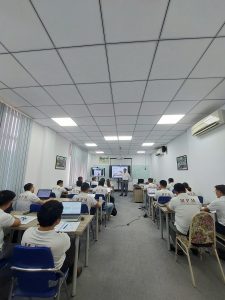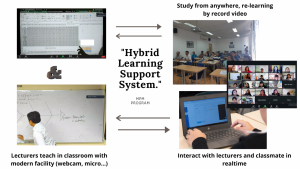
Hybrid learning is one of the most frequently mentioned terms in the education sector within the context of the “new normal.” So, what exactly is hybrid learning? Why is this mode of learning set to be a cornerstone in the future development of education? Let’s delve into these questions with MPM – Master of Project Management in Construction and explore further in the article below!
What is Hybrid Learning?
Higher education has been transformed by technology to better meet students’ unique learning needs and styles. These innovations have changed how and where students study, from learning management systems (LMS) to adaptive learning software and video conferencing.
Hybrid learning is when conventional face-to-face teaching is combined with offline or distance learning approaches, like experiential learning and remote course delivery. The aim is to use the right combination of learning strategies to efficiently teach content while still meeting students’ learning needs. The additional learning strategies are intended to supplement rather than replace conventional face-to-face training.
Hybrid is a new educational methodology that enables learners from different locations to participate in a live classroom session simultaneously.
In all hybrid learning sessions, instructors use recording devices to broadcast live classroom activities to online platforms. In this setup, both the instructor and all learners interact together, even those who are not physically present in the classroom.
With this approach, learners can adjust their personal schedules, attending classes for direct interaction and discussions when needed, or opting for online learning from home without affecting their knowledge absorption. This method combines the strengths of traditional learning with the convenience of technology. Furthermore, learners gain access to various digital education platforms to support self-learning, research, and assignments.
Moreover, Hybrid learning has given rise to the concept of “flipped classrooms” – a learning model where instructional content is provided beforehand, and class time is used for addressing questions, interaction, discussions, and developing new ideas when learners come prepared. This model sets the foundation for a multi-dimensional learning trend in the future, utilizing technology to foster interactive learning rather than one-way online instruction.
Additionally, hybrid learning helps address the challenge of “distance” in education, offering an alternative experience to the traditional offline learning that has been the standard in education.

Who is Hybrid Learning For?
Designed to align with modern lifestyles, the MPM – Master of Project Management program applies the Hybrid approach, making it suitable for various individuals, especially those with busy schedules such as:
– Students who are simultaneously working.
– Professionals with frequent work-related travels.
– Young parents juggling work and family responsibilities.
Distinguishing Hybrid Learning from Other Online Learning Approaches
The term “online learning” is often used broadly, while there are various forms of online learning based on the proportion of “online” content. To simplify comparison, we can view the current education landscape through four learning approaches:
1. **100% Offline**: All learning occurs in traditional classrooms, with some supplementary online applications for communication with instructors, but these are not considered a formal part of the learning process.
2. **Blended Learning (75% In-person – 25% Online)**: Classes are divided into about 75% in-person and 25% online. Learners participate either in-person or online for each session. However, the online component tends to focus on less critical topics. Digitized materials and communication tools are integrated into this approach.
3. **100% Online**: All learning takes place online, including classes, materials, and interaction between instructors and learners.
4. **Hybrid Learning (50% Online – 50% Offline)**: This approach strikes a balance between online and in-person learning at a 50-50 ratio. Classes run both in-person and online simultaneously, giving learners the autonomy to choose their participation mode. Technology applications like digital materials and chat platforms are utilized for preparation, allowing learners to decide whether attending in-person sessions is necessary.
Blended learning and hybrid learning are often confused due to their combination of online and in-person elements, but their usage methods differ.
Blended learning still emphasizes in-person instruction, utilizing online platforms to supplement with digitized materials and additional information exchange to reinforce learners’ knowledge.
In contrast, hybrid learning equally values online and in-person components, aiming to maintain consistent quality across all sessions for learners’ convenience. Hybrid learning is designed to encourage learners to prepare and research using online resources prior to in-person sessions. Offline sessions then become an opportunity for learners and instructors to engage in discussions and delve deeper into lesson content.
Integrated learning is not just a short-term trend; it’s predicted to revolutionize education, as more educational institutions express interest and adopt it. So, what distinct benefits does integrated learning truly offer compared to other learning methods?

Benefits of the Hybrid Learning Model
Hybrid learning has been a prominent concept for years due to its ability to optimize learning efficiency and convenience for both learners and educators. The emergence of the COVID-19 pandemic has further illuminated the effectiveness of this model in the context of social distancing. Notable benefits of the hybrid learning approach include:
1. **Personalized Learning Journey**: Learners actively manage their learning process. From time management for attending online and offline sessions to cultivating personal discipline and planning self-study on program topics, learners design their own learning journey. Hybrid learning acknowledges that each individual’s pace and absorption of information vary, allowing learners to tailor the most suitable path for themselves.
2. **Learning Anytime, Anywhere, Promoting Educational Equity**: On a personal level, the convenience of hybrid learning enables learners to balance personal commitments alongside education. While learners can prioritize personal engagements, they can still maintain their studies. From a societal perspective, erasing the barriers of knowledge distribution brings forth numerous talents, fostering swift societal development.
3. **Cost-Effective Learning**: Hybrid learning saves time, costs, and resources. Learners can allocate time and effort for research and reference materials, while optimized resource usage minimizes the need for excessive physical facilities, converting learning materials into digital format. Eliminating gradually diminishing hurdles offers significant advantages, potentially redefining education’s future.
4. **Multidirectional Interaction and Program Flexibility**: Programs adopting the integrated learning model are designed with various technology-driven activities that allow online and offline learners to interact with each other and with instructors. Additionally, learners can swiftly provide feedback to instructors and institutions for refining program content.
Hybrid learning is undeniably opening a new chapter and direction for the future of education. This model addresses the shortcomings of traditional education, harnessing technology’s maximum potential to empower learners holistically, rather than merely aiding material digitization. Moreover, integrated learning initiates innovative, optimal learning methodologies.
In the digital age, all fields are evolving and reaching new heights, and education is no exception. Not only hybrid learning, but numerous other advanced methods will provide equal learning opportunities and global integration. To seize these opportunities, the only strategy is to adapt and continuously update new learning methods, with hybrid learning potentially leading the way.
At MPM – Professional Master of Project Management in Construction, the utilization of the Hybrid learning system maximizes teaching and learning quality, enabling MPM students to partake in their studies from anywhere.
